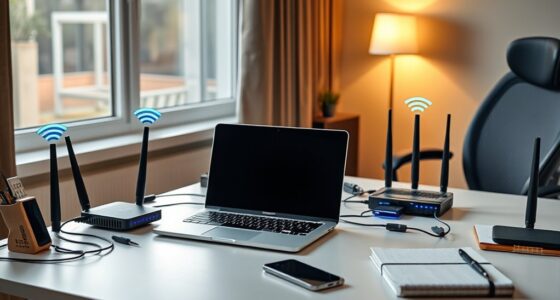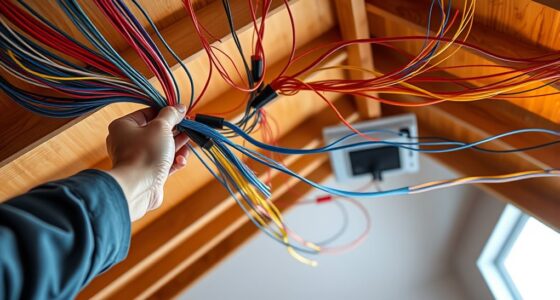Setting up a secure home network is essential to protect your personal data and devices from cyber threats. By implementing the right security measures, you can create a safer online environment for everyone in your household. But knowing where to start and what steps to take can be challenging. To guarantee your network is truly protected, it’s important to understand the key practices that make a difference—and that’s what we’ll explore next.
Key Takeaways
- Use the latest Wi-Fi encryption standard, like WPA3, and avoid outdated protocols such as WEP or WPA.
- Regularly update your router’s firmware to patch security vulnerabilities and improve performance.
- Change default admin passwords to strong, unique credentials and disable remote management features.
- Enable a guest network with separate credentials to isolate visitors from your main devices.
- Monitor connected devices frequently and remove any unfamiliar or unauthorized devices promptly.

In today’s connected world, securing your home network is essential to protect your personal information and devices. The first step is ensuring that your Wi-Fi connection is protected through strong Wi-Fi encryption. When you set up your router, look for the wireless security settings and choose the latest encryption standard available, such as WPA3, if your router supports it. WPA2 is still secure, but WPA3 offers enhanced protections against eavesdropping and brute-force attacks. Avoid using outdated encryption methods like WEP or WPA, as they are vulnerable to hacking attempts. Making this simple change drastically boosts your network’s security and keeps unwanted visitors from accessing your data.
Secure your home network with the latest Wi-Fi encryption like WPA3 to prevent unauthorized access.
Another critical aspect is keeping your router firmware up to date. Router manufacturers regularly release firmware updates that patch security vulnerabilities and improve overall performance. Regularly check your router’s admin interface for any available updates, and set it to update automatically if possible. Outdated firmware can leave your network exposed to malware, unauthorized access, and other cyber threats. Updating firmware is a straightforward process, but the benefits are substantial. It guarantees your router has the latest security features and fixes, making it more resistant to attacks. Additionally, choosing a router with advanced security features can further enhance your network protection.
Change your default admin password immediately after setting up your router. Default credentials are well-known among hackers and are often the first thing they try when attempting to access your network. Create a strong, unique password that combines letters, numbers, and symbols. This extra layer of protection prevents unauthorized users from gaining control of your router’s settings, which could compromise your entire home network. Additionally, disable remote management features unless you need them, as they can be exploited if left enabled.
You should also consider enabling a guest network for visitors. This keeps your primary network isolated from devices that don’t belong to your household. By doing so, you limit the exposure of your main network to potential threats from less secure devices. Make sure to secure the guest network with its own strong password and avoid sharing it widely.
Finally, review your network’s connected devices regularly. Use your router’s admin panel to see which devices are connected, and remove any unfamiliar ones. This proactive approach helps identify potential intruders early, allowing you to take action before any damage occurs. By combining strong Wi-Fi encryption, keeping your router firmware updated, changing default passwords, and monitoring connected devices, you create a robust defense for your home network. These steps may seem simple, but they’re crucial for maintaining your privacy and ensuring your digital life stays secure.
Frequently Asked Questions
How Often Should I Update My Router’s Firmware?
You should update your router’s firmware at least once a month to maintain ideal router security. Regular firmware updates patch vulnerabilities and improve performance, keeping your network safe from threats. Check your router’s settings or manufacturer’s website for updates frequently, especially after security alerts. Staying proactive with firmware updates ensures your home network stays protected and runs smoothly, reducing the risk of cyberattacks or unauthorized access.
What Is the Best Way to Create a Strong Wi-Fi Password?
You should create a strong Wi-Fi password by focusing on password complexity, combining uppercase and lowercase letters, numbers, and special characters. Avoid common words or patterns, making it harder for hackers to guess. Use a reliable password management tool to store and generate unique passwords for your network. Regularly update your password and never reuse it across different accounts to maintain your network’s security.
Can I Segment My Network for Added Security?
Think of your network as a castle; you can build walls to protect your treasure. Yes, you can segment your network for added security by creating separate zones, like a guest network setup. This way, visitors access only the designated area, leaving your main network safe from potential threats. Network segmentation acts as an extra layer of defense, keeping your private data shielded while offering convenience to guests.
How Do I Detect Unauthorized Devices on My Network?
You can detect unauthorized devices on your network through network monitoring tools that scan connected devices regularly. Make certain device authentication is enforced, so only trusted devices can join. Check your router’s admin interface for a list of connected devices and look for unfamiliar ones. Set up alerts for new device connections, and update your network security settings to prevent unauthorized access. This proactive approach keeps your network secure and monitored.
What Are the Risks of Using Public Wi-Fi Networks at Home?
Using public Wi-Fi networks at home exposes you to vulnerabilities like data interception and malware risks. Public Wi-Fi vulnerabilities mean hackers can eavesdrop on your activity if your home network encryption isn’t strong. Even if you’re just at home, avoid connecting to unsecured public networks without a VPN. Always make certain your home network encryption is current and robust, protecting your devices and personal information from potential threats.
Conclusion
By following these steps, you’ll create a home network that’s as impenetrable as a fortress. Regularly update your firmware, use strong passwords, and enable WPA3 encryption to keep cyber threats at bay. Remember, a secure network isn’t just a small step—it’s your first line of defense against hackers trying to invade your digital life. Take control now, and turn your home into a cyber fortress that even the most determined intruders can’t breach.









